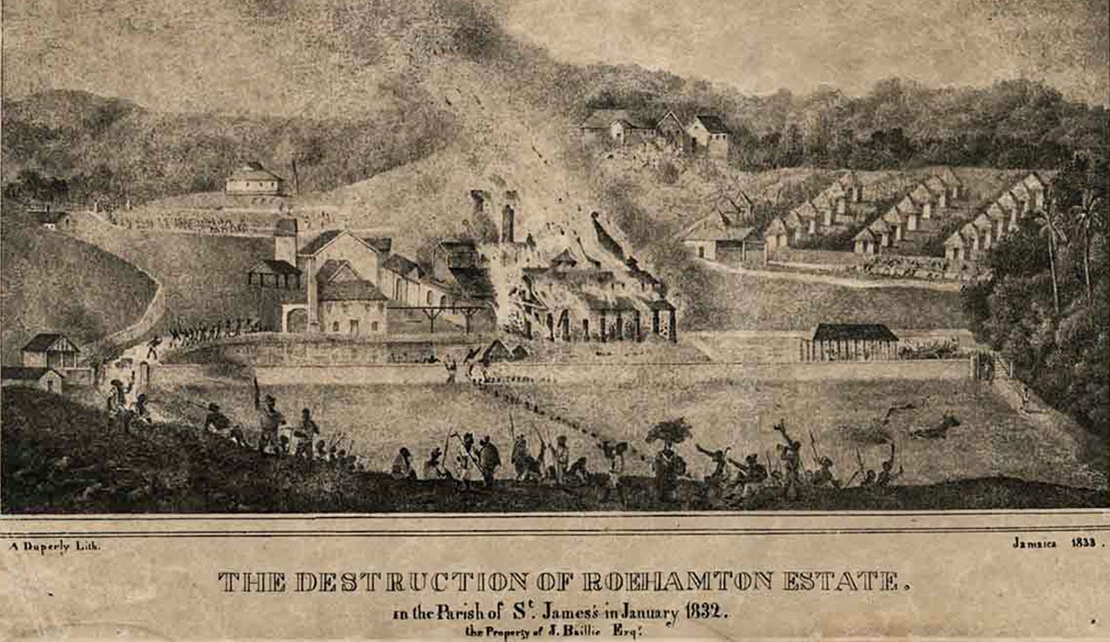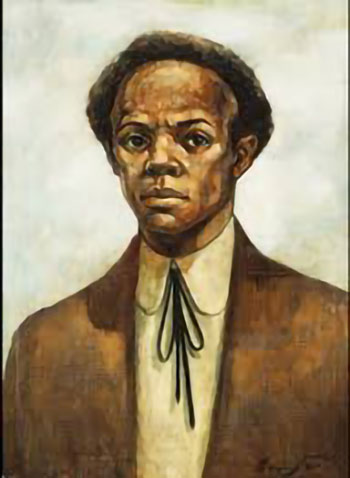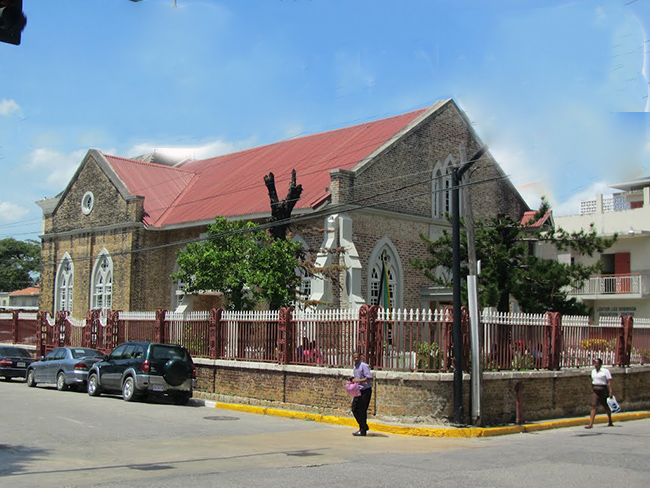That Kensington fire which started the Sam Sharpe War of 1831/32

FOR several years now, beginning around the year 1975 when Sam Sharpe, the leader of the 1831-32 Rebellion, was declared a national hero, pilgrimages have been made to Kensington Estate — the location in St James from which the beacon by fire was lit as the start of what is widely known in Jamaica's history as the Christmas Rebellion, Sam Sharpe Rebellion, or the 1831-32 Slave Insurrection.
These pilgrimages involved many schoolchildren and their teachers who visited on educational tours. And at Christmas time there has been, annually, a politico-historical event at the Kensington Estate location involving high-profile speakers: historians, sociologists and anthropologists, to which hundreds of people from near and far are invited.
The organisers comprised some of the same people who were behind the change of date (May 1, 1981) for the celebration of Montego Bay being declared a city by then Governor General of Jamaica Sir Florizel Glasspole.
These parochial wisemen's action in respect of this matter more than suggests that Sir Florizel and his army of competent advisors, including distinguished legal luminaries, all did not know what they were doing. But this confusion with the preceding matter in respect of the date for the MoBay city status celebration did not stop there.
One of their next victims of uncontrollable and misguided exuberance was their “teachings “ for many years ... that Kensington Estate is Tulloch Castle Estate, and that it was from the Tulloch Castle property that the fire to begin the Christmas Rebellion of 1831-32 was lit. Tulloch Castle Estate is a totally different property named after its owner John Tulloch of Ross, Scotland, from 1769-1837.

The Rev Hope M Waddell, Presbyterian missionary based in the parish of St James, who returned to his station at Cornwall near Mount Zion and above Rose Hall Estates on the evening of December 27, described the unfolding dangerous situation: “The congregation which had assembled was disappearing in affright, and would not return to my call. The only answer that could be got was, 'Palmyra on fire'!
It was not an ordinary estate fire they spoke of … it was the pre-concerted signal for our part of the country that the struggle for freedom had begun. It was in response to the “Kensington on fire”, another sugar estate high up the mountains towards the interior.
Both Palmyra and Kensington were visible to each other and over a great stretch of intermediate country. One hoisted the flaming flag of liberty, and the other saluted it, calling on all between and around to follow their example. And it was followed! These were the grand beacon fires … scarcely had night closed in when the sky towards the interior was illuminated by unwonted glares, as fires rose here and there in rapid succession.
In Trelawny parish next door, the rebels had arranged for similar beacon signals. Shaw Castle Estate was set on fire and Georgia Estate, in answer to the beacon, as both of them were elevated situations. Tulloch Castle Estate, while elevated, lacked high visibility from long distances, but its incendiary capacity was just as good as its neighbours. Kensington Estate next door was owned by the Morris family, headed by John H Morris.

The University Library Unit revealed the names of over one dozen men who demolished the Market Street Baptist Church (Sam Sharpe Church). Two or three of those men bear the Morris surname, all connected to Kensington Estate which was burnt by Sam Sharpe's rebels to the ground. Sweet revenge for the Morris clan of Kensington? It would have been nice if the “parochial wisemen” could use their abilities in a manner that is more helpful in getting our people, like any sensible nation, to understand their past, even as we look to the future, instead of masquerading as a fountain of knowledge while spouting publicly confusing and contradictory items of political and historical information, and which cannot withstand external defensibility.
It was such a futile endeavour, for in contrast to our distant past, information can be easily checked and verified. It will take some time to reverse this careless rumour told to particularly so many schoolchildren over the years that Kensington Estate is Tulloch Castle Estate. It is absolutely not true. The beacon to signal the start of the Sam Sharpe Rebellion 1831-32 was lit at the Kensington Estate by a slave named John Dunbar — a medicine man and healer attached to the slave hospital on that estate.
A sober-headed man and active senior member of the Salters Hill Baptist Church, Dunbar was respected both by blacks and whites alike. The Rev Sam Reid and Mr Don Carter Henry have him in their books “as a slave who was drunk and prematurely lit the trash house at Kensington”. Why would Sam Sharpe and his lieutenants give such an extremely weighty assignment to a drunkard? But yet the “kakanabu” stories continue unabated, including one that the rebels could not take Montego Bay because on reaching Long Hill from Montpelier, they stopped to quarrel who should be crowned king in the town and as a consequence lost their opportunity to capture Montego Bay.
There was not one, but four columns of slaves marching towards MoBay. Therefore, if such a need to select a king had arisen, since Sam Sharpe was alive and well, one of four columns of slaves could not decide this matter. The four columns of slaves streamed towards Montego Bay from the north, south, east and west and from the parishes of St James, Trelawny and Hanover. Their aim was to burn the town to the ground, thus creating shock and awe in England about the seriousness of the Jamaican slaves towards their need for the abolition of slavery.
The absentee landowners, many of whom had never visited their plantation in Jamaica, along with merchants and some former owners of slave ships, banded together in a lobby group called the West India Interest, based particularly in London and Liverpool. These lobbyists began to spread propaganda to cauterise or break the back of the massive agitation by the general public in England that the empire must end chattel slavery.
The West India Interest continued to argue strenuously that the increased restiveness of the Jamaican slaves was due to the fact of them becoming unhappy that they will soon be without a slave master, and not owned any more by anyone. Sam Sharpe and the other slaves were fully briefed on the antics of the West India Interest and decided to “mash down that lie” by burning Montego Bay to the ground.
But watch the prejudicial and racist bias in the pattern of the recording and reporting of the Sam Sharpe Rebellion and our history generally. The bottom line consistently is that any activity in which the Negro is engaged comes to naught because of his/her own divisiveness and stupidity. The long arc of our truthful and authentic history bends towards a different story: that while we were never perfect, we were also never fools.
We built the great houses and other palatial mansions, aqueducts, water dams, sugar factories ... also manufactured the rum and the sugar, created wharves, docks, the Gothic church buildings and others, the bridges over wide and raging rivers including Flat Bridge in the parish of St Catherine, trained the horses and other animals, while providing veterinarian services through the use of bush medicine. We repaired the buggies, cooked the meals of the slave master family, and cared for their children ... while giving birth to many as they grew into adulthood.
The slaves buried the dead of the white slave-owning families also. We changed significantly the religious practices of European Christianity, brought by the white missionaries from England, into Pocomania and native Jamaican Revivalism, with a strong, Afrocentric rhythm and focus. The traditional Christian choruses are now intertwined with and intermingled by dub poetry within our churches. And reggae music has arrived at its optimal felicity within worship, importing a glorified revolution.
This imagery in a secular and contemporary warfare amounts to a “bloodless coup”!
Lastly, the slaves provided manpower and guerilla skills in the liberation wars (slave rebellions) waged for close to 200 years, and by so doing laid the early foundations for a political philosophy grounded in the concept of freedom and democracy. And they were oftentimes assisted by revolutionary agents from United States of America and Haiti, which we must not forget.
The consistent image of us in the cane field, in the boiling sun, under the scourge of the whip is an inaccurate and poor representation of the Negro contribution to Jamaica's development, even during slavery. But look at some of whom are, perhaps unknowingly and unwittingly, spreading unsubstantiated disrespectful stories about our ancestors?
Similarly, those white slave masters who were against the system of slavery, despite the fact that they were beneficiaries, but who still provided material and logistic support to the slaves in rebellion, they too have been written out of the history books by the white chroniclers.
So too were the two white navy men from the British war ships HMS Sparrowhawk and HMS Racehorse in MoBay Harbour, during the Sam Sharpe Rebellion, who abandoned ship to join and fight with the slaves for freedom. They too must not be forgotten. We ought to join hands to clean up the mess in our history, generally. A lot of corrective work needs to be done to restore integrity to our history.
I have spent 35 years surveilling this history at key centres around the globe. But equally important, I have scrutinised much of the history of local communities across Jamaica. This is where things get even more interesting, very,very interesting.
Do check out the story of the slave Halifax in Professor Orlando Patterson's book: The Sociology Of Slavery.

 Ar
Ar  En
En